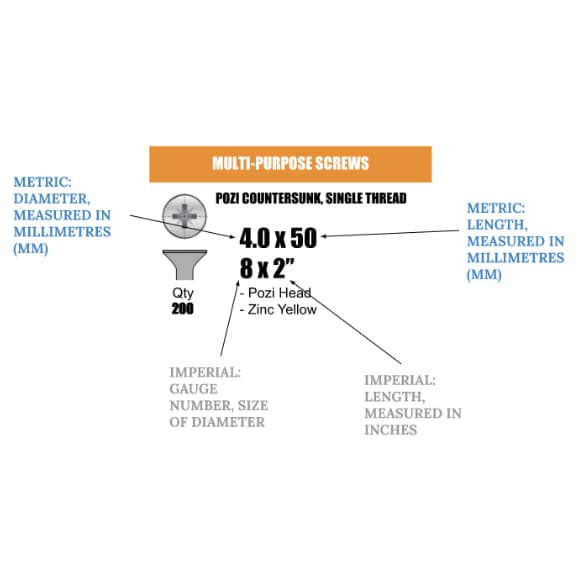Navigating screw sizes can be confusing, especially when switching between metric and imperial systems. Here we simplify the process, explaining the differences and conversions between these two measurement systems. Whether you’re a DIY enthusiast or a professional, understanding screw sizes will help you choose the right hardware for your projects.
Selecting the right screw sizes can be a challenge, especially if you are unfamiliar with the various sizes that are quoted on the packaging, often both in metric and imperial.
It is also useful to know which type of screw is best for the job at hand. Using the correct screw can help avoid any mistakes or damages when fastening onto the respective material.
You can learn about the common types of screws and their functions in our comprehensive guide further down. Alternatively, if you’re here to convert measurements from metric to imperial (and vice-versa), scroll down to take a look at our handy conversion chart to help you find the right size screw.
Screw Size Conversion Chart (Metric to Imperial)
Please use this chart to convert metric to imperial screw sizes. Screw measurements are available on the packaging itself. Some manufacturers will not provide these details on the product description page when purchasing online.
Please note that the following chart does not show exact measurements, but acts as a general guide.
METRIC SIZE
DIAMETER (mm) x LENGTH (mm)
3.0 x 12
3.0 x 16
3.0 x 20
3.0 x 25
3.0 x 30
3.0 x 40
3.5 x 12
3.5 x 16
3.5 x 20
3.5 x 25
3.5 x 30
3.5 x 40
4.0 x 12
4.0 x 16
4.0 x 20
4.0 x 25
4.0 x 30
4.0 x 35
4.0 x 40
4.0 x 45
4.0 x 50
4.0 x 60
4.0 x 70
4.5 x 25
4.5 x 30
4.5 x 35
4.5 x 40
4.5 x 45
4.5 x 50
4.5 x 60
4.5 x 70
4.5 x 75
5.0 x 25
5.0 x 30
5.0 x 35
5.0 x 40
5.0 x 45
5.0 x 45
5.0 x 50
5.0 x 60
5.0 x 75
5.0 x 80
5.0 x 90
5.0 x 100
6.0 x 30
6.0 x 40
6.0 x 50
6.0 x 60
6.0 x 70
6.0 x 75
6.0 x 80
6.0 x 90
6.0 x 100
6.0 x 110
6.0 x 130
6.0 x 150
IMPERIAL SIZE
GAUGE x LENGTH (inches)
4 x ½”
4 x ⅝”
4 x ¾”
4 x 1”
4 x 1 ¼”
4 x 1 ½”
6 x ½”
6 x ⅝”
6 x ¾”
6 x 1”
6 x 1 ¼”
6 x 1 ½”
8 x ½”
8 x ⅝”
8 x ¾”
8 x 1”
8 x 1 ¼”
8 x 1 ⅜”
8 x 1 ½”
8 x 1 ¾”
8 x 2”
8 x 2 ⅜”
8 x 2 ¾”
9 x 1”
9 x 1 ¼”
9 x 1 ⅜”
9 x 1 ½”
9 x 1 ¾”
9 x 2”
9 x 2 ⅜”
9 x 2 ¾”
9 x 3”
10 x 1”
10 x 1 ¼”
10 x 1 ⅜”
10 x 1 ½”
10 x 1 ¾”
10 x 2”
10 x 2 ⅜”
10 x 2 ¾”
10 x 3”
10 x 3 ¼”
10 x 3 ½”
10 x 4”
12 x 1 ¼”
12 x 1 ½”
12 x 2”
12 x 2 ⅜”
12 x 2 ¾”
12 x 3”
12 x 3 ¼”
12 x 3 ½”
12 x 4”
12 x 4 ⅜”
12 x 5 ⅛”
12 x 6”
Imperial & Metric Screw Sizes Explained
The choice between using metric or imperial falls to a matter of preference.
Using the metric system is becoming increasingly popular, however, but can still be a little tricky to understand for those who prefer to work with imperial equivalents.
Whichever one you choose makes no difference to the performance of the screw.
To put it simply:
Below is a typical example of a product label with the screw size measurement both in metric and imperial. If you are not sure of the size or type of screw, this is the sort of thing you should look out for.

Imperial Screw Sizes
There are two different numbers printed on the product label (8 x 2”).
The first number refers to the size of the (major) diameter, which is given as the ‘gauge’ number. Quite simply, the larger the number, the larger the diameter.
A gauge number of 12 is larger than a gauge of 8, for example.
The second number is the length of the screw given in inches.
Note: The length given for the screw is the length that is fastened or buried in the respective material.
It is a slightly different case for the head of a raised or dome-headed screw, as the heads sit on top of the surface material, compared to a flat head that will sit flush with the surface.

Metric Screw Sizes
The other set of two numbers are the measurements in metric (4.0 x 50). The first number, rather than using a ‘gauge’ number, indicates the (major) diameter in millimetres (mm). The second number indicates the length, also measured in millimetres.

‘M’ Rating

You may see an ‘M’ rating on some products, followed by a number. ISO metric fastener sizes are specified by diameter, pitch and length, in millimetres. For example
M10 x 1.0 x 80mm
The image above shows a product where the pitch isn’t specified. M10 x 80mm would mean that the diameter is 10mm and the length is 80mm.
Since there is no thread pitch listed, the fastener is assumed to be a coarse thread by default.




